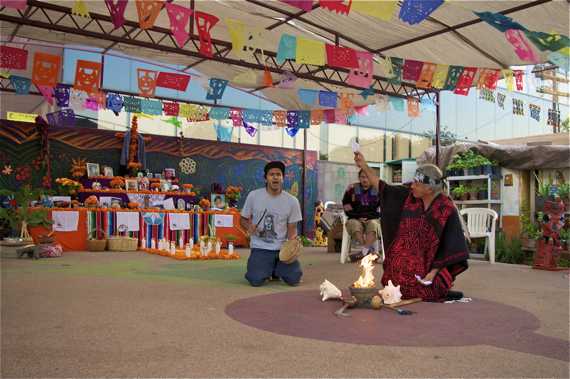
As I sat down to watch the performance by Kalpulli Tlaltekuhtli for the "movement is medicine" segment of the La Cultura Cura Día de los Muertos celebration at Proyecto Jardín, I was (once again) reminded of my encounter with displaced Afro-Colombian farmers in Bogotá, Colombia, a decade earlier.
Uprooted from the tropical and resource-rich region of the Chocó by those seeking to make their fortunes mining, growing coca, or doing large-scale farming, these descendents of former slaves were despondent that they would no longer be able to pass on their agricultural techniques to their children.
Their farming practices, which were specific to their Bantu heritage, were of little use to them in their sprawling community of tiny, hastily-built brick huts perched precariously on the barren hillsides of Soacha, the settlement/city outside Bogotá to which they had fled.
Without that connection to their land, they had told me, they were "lost" and afraid that their children would not know who they were as a people.
The belief that cultivation of the land is the key to reconnecting people with their heritage and humanity seems to drive a number of the gardening initiatives I've encountered over the past couple of years (here, here, here). The celebrations at Proyecto Jardín this past Sunday, however, took that effort to a whole new level.
The garden, nestled behind the White Memorial Medical Center in Boyle Heights, was one of the first hospital-based gardens in the country created with the goal of empowering youth to work with adults and elders to transform public space, cultivate the earth, promote health and physical activity, and engage in education and advocacy, all while incorporating arts and cultural traditions relevant to the community they served.
Over the past decade-plus it has served as a hub for nutrition and cooking classes, fitness classes, agricultural learning, and events aimed at consciousness-raising and organizing around social justice issues. It is also a uniquely peaceful and lush environment capable of making you forget you're standing in the heart of a triangle of freeways.
Although the event on Sunday took on the question of healing using dance, talking circles, spoken word, culture, music, and community, the garden space itself was essential to the endeavor.
The dancer introducing the performance opening the day's ceremonies spoke of how important it was to be in a place of nature and beauty like the garden so as to make it possible for those present to both root ourselves in the community while connecting more easily with the spirits of those that had passed.
They then danced in front of the altar covered in cempasuchil flowers and ofrendas, saluting the four directions, memorializing those lost, and celebrating life.
When they had finished, Canek Peña-Vargas, son of the garden's executive director, Irene Peña, and a continuation high school teacher I first met earlier this summer, gathered everyone into a circle for a dialogue intended to honor the memory of those lost while helping us take collective steps forward in healing.
After all of the 40 or so participants in the discussion had had a chance to introduce themselves and their heritage, Peña-Vargas spoke of the challenges of finding peace in honoring the dead when what led to their deaths was not always so honorable.
His own students, for example, most of whom came from troubled circumstances, often struggled with how to deal with the losses they experienced. Substance abuse, gang violence, curable disease, and even police brutality might be the killers they were more commonly acquainted with.
Many, he said, preferred to push their feelings aside and power their way through pain, saying things like, "Aw, mister, smile now, cry later."

It turns out his students were not the only ones.
One young man spoke of losing a 13-year-old brother to an asthma attack. He had grown up in South Central, where asthma rates are 11% higher than elsewhere in L.A. County, and the ambulance that arrived an hour after they first called was too late to do any good.
Another young woman spoke of having lost a relative in the prime of his life to health problems incurred at his workplace and a lack of access to health care. She was angry to have lost someone she cared about to things like unjust working conditions and inadequate health care options -- problems that affect some of the hardest working but least well-to-do members of society.
A housing advocate and lawyer spoke on behalf of those whose lives were upended by displacement and either were mortally weakened by having to move from their homes or by the struggle for the right to live out their lives with dignity in the homes they had spent so much of their lives in.
Someone else spoke of how his grandfather had suffered from post-traumatic stress after returning from war and had never recovered.
Even I struggled with the idea of "honoring" our lost ones, thinking of those I have been interviewing over the past year and the extent to which the constant and violent culling of youth of color can batter communities.
It was almost a relief when Peña-Vargas asked participants to hand him their handwritten messages to loved ones to be burned in a ritual fire.
The smoke would go to the ancestors, explained healer Cuco Esperansa, as he kneeled over a bowl that held burning sage.
As Peña-Vargas sang a Native American song, Esperansa waved each of the papers over the fire before dropping them in, coaxing their smoke up to the sky, and telling a native tale of where flowers came from.
"These are the seeds of your ancestors that you have planted," he concluded the tale as the fire died down.
"They will grow into flowers. Plant more gardens."










